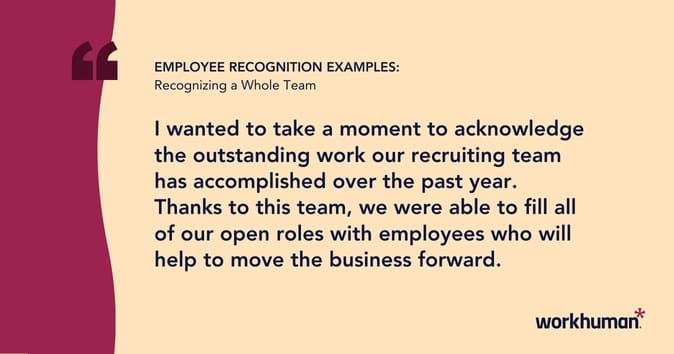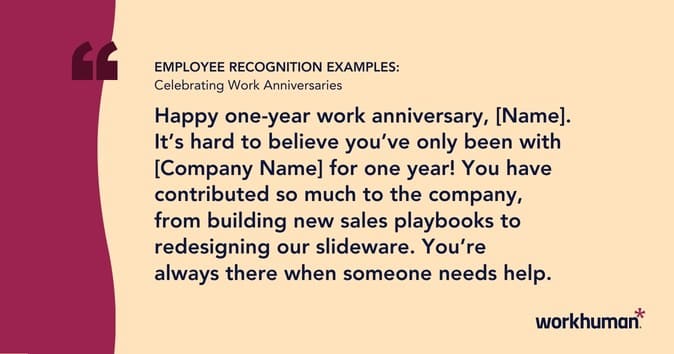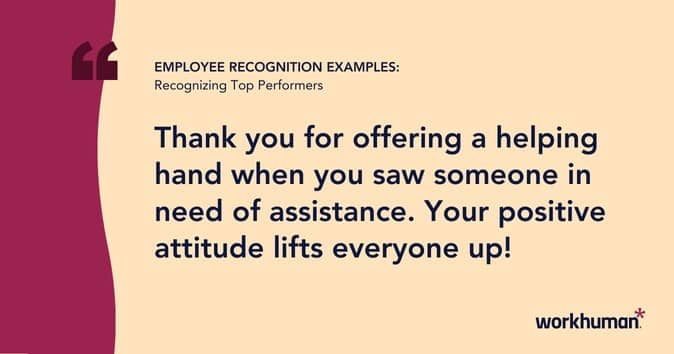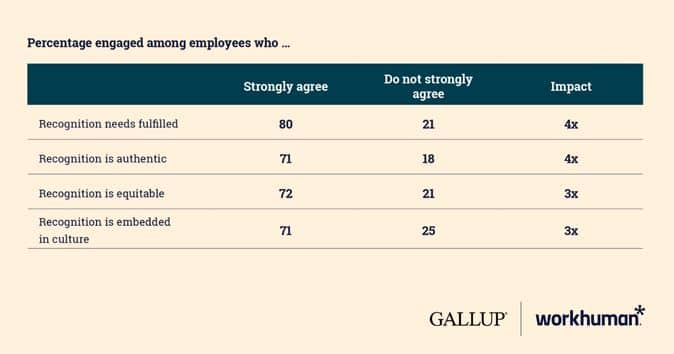16 Employee Recognition Examples to Boost Engagement and Satisfaction

Each year, organizations set new goals and priorities to move the business forward. Typically, these initiatives are around improving business performance and profitability, employee productivity and innovation, brand awareness, or market share.
The goals are usually measured quantitatively, but achieving them requires more than a spreadsheet. New priorities in today’s workplace rely on employees, their skills profiles, and their connection, engagement, and dedication to the company.
Whatever goals you're striving for, there’s a good chance a well-thought-out employee recognition program can help reach them. In fact, researchOpens in a new tab has found organizations with a formal recognition program are 12x more likely to have strong business outcomes than those without a formal program.
In this post, we look at how employee recognition contributes to a thriving workplace and provide employee recognition examples to build up your employees and your business’s success.
Why is employee recognition important?
People thrive when they are supported, listened to, and appreciated. It’s human nature. Employees don’t stop being human when they get to work or power on their laptop at home – they need those things to thrive at work, too.
Yet, it continues to be something organizations repeatedly look over despite its potential.
In fact, a workplace study from Workhuman® and Gallup found that 81% of managers and leaders say recognizing employees is not a major strategic priority at their organization.
Employee recognition is important because it creates a return on investment on a host of levels. It can build up employees to feel and perform better. It can make them less stressed and more engaged. But to get that return, it requires a strong and authentic culture of appreciation, which takes some effort.
With a formal recognition program, however, you can take much of the guesswork out of building and sustaining that kind of culture. A systematic recognition program with measurable criteria for employee recognition and a defined process that includes all employees transforms appreciation into a business driver.
Some organizations may see the benefit of thanking their employees, but aren’t willing to shell out the capital to create a systematic way of doing so. This attitude often leads to ad hoc or homegrown recognition programs that lack engagement and visibility, diminishing the return a recognition moment can have on employee satisfaction and morale in the long run.
To address this, consider incorporating employee of the month ideas to create a more structured and impactful recognition program.
Leaders looking for a recognition solution that will actually move the needle on business metrics need to go further than an ad hoc approach, and move toward a comprehensive, social, and equitable employee recognition solution. And that’s when the employee recognition examples shared below will really start to make an impact.
For more information about the return on investment recognition can bring to your organization, check out this white paper.
16 employee recognition examples to try
Now that we’ve gone over the benefits of employee recognition programs and some of the factors to keep in mind, it’s time to start putting it into practice. We will go over some of the most common reasons for recognition as well as great employee recognition examples to be inspired by.
If you do choose to recognize a staff member or multiple team members with these examples, remember to add in your unique perspective to personalize the message. Being specific makes all the difference.

Employee recognition examples for top performers
- "[Name], thank you for your hard work on [Project X]. Because of your skills and dedication, you’ve directly impacted the company’s success. Keep up the good work!"
- "Wow! We needed to meet our quota for the month and you seriously stepped up. Not only did you surpass your own quota, but your extra effort inspired other members of the team to do so, too!"
Recognizing a whole team
- "A huge shout out to the creative team for building out a new look and feel for the company website. Reimagining our brand design couldn’t have been easy, but you came together with a great attitude and the results are amazing!"
- "I wanted to take a moment to acknowledge the outstanding work our recruiting team has accomplished over the past year. Thanks to this team, we were able to fill all of our open roles with employees who will help to move the business forward."

Ideas to recognize your own team member
- "[Name], I can’t tell you how much I appreciate your help on [Project Y] last week. Not everyone would be willing to stop what they are doing to help a colleague parse through a complicated contract. I truly appreciate you going the extra mile."
- "Being new on the team, I was nervous about leading my first meeting with the group. But thanks to you I feel valued and welcomed. Thank you for living up to the company’s core values!"
Calling out amazing work from managers & team leaders
- "As someone just entering the workforce, I feel so lucky to have you as a boss and mentor. Your actionable advice and positive feedback have already made me feel like I am a valued member of the team, and I can’t wait to continue growing!"
- "From the entire team, thank you for being such an amazing leader. Your ability to keep the team’s morale high even during the most difficult of times is inspirational. Thank you for all you do."
Celebrating work anniversaries
- "Happy one year work anniversary, [Name]. It’s hard to believe you’ve only been with [Company Name] for one year! You have contributed so much to the company, from building new sales playbooks to redesigning our slideware. You’re always there when someone needs help."
- "[Name], when you started working at [Company Name] 10 years ago, it looked nothing like what it does today, and much of that change is because of you! Your ongoing dedication to the success of the business has not only grown our customer base, but has also led the vision for what we can be. Thank you!"

Recognize employee achievements and professional development
- "I wanted to take a moment to applaud you on your continued work ethic. Learning a new computer programming language on your own couldn’t have been easy, but you took the challenge in stride."
- "[Name], congratulations on earning your certificate in environmental and sustainability governance (ESG) reporting! As the company builds out its ESG strategy you will be an invaluable contributor. We appreciate you taking time out of your daily responsibilities to help us become more environmentally sustainable."
Reward employees for going above and beyond
- "Thank you for not only participating in our new mentorship program, but for offering to help lead the group’s ongoing efforts! We have been working on this initiative to connect new employees with more tenured colleagues for a few months now, and we wouldn’t have made it to where we are now without you!"
- "We see you live our company values each and every day, and appreciate the positive energy you spread throughout the BDR team. Our prospective clients feel it too. Keep up the good work!"
General employee appreciation ideas
- "Thank you for offering a helping hand when you saw someone in need of assistance. Your positive attitude lifts everyone up"
- "What would I do without you? [Project Z] didn’t go as we originally intended, but you never missed a beat, helping us to meet the project deadline. Thank you for doing such an incredible job."

Tips for making the most of an employee recognition program
Knowing what you want to say in your recognition efforts is important, but it’s not the only thing you should know. Organizations looking to boost employee engagement and productivity through recognition also need to be aware of the factors that go into building a sustainable and effective culture of recognition.
5 pillars of employee recognition
Research from Workhuman and Gallup determined that there are five main pillars to strive for when recognizing an employee for great work.
- Fulfilling – recognition should be given in a consistent and reliable manner.
- Authentic – recognition should be given genuinely and be tied back to specific achievements.
- Equitable – recognition standards, values, and expectations should be fairly distributed across all employees.
- Embedded in culture – recognition should be freely given and received up and down the company; not just from a manager to a report.
- Personalized – recognition should be given in accordance to individual employee preferences.
When employee recognition does fall under those pillars, the results are impressive across the board, especially when it comes to engagement.

As the Workhuman-Gallup report, "Unleashing the Human Element at Work: Transforming Workplaces Through Recognition," explains:
"Managers and supervisors play a critical role in engaging employees. Employees who receive recognition from their manager, supervisor or other leaders at least a few times a month are more than 3x as likely to be engaged than those who receive it less often. However, managers can lose the full force of recognition by failing to personalize it. Fifty-one percent of employees who report being asked about their preferences are engaged, versus only 31% of those who were not — a 20-point difference in engagement."
Now that we are familiar with the pillars that make up good employee recognition as well as some quick employee recognition statistics, let’s dive into some particular considerations.
Expected vs. unexpected employee recognition
As we know from the first recognition pillar, workplace recognition should be given in a consistent and reliable manner. To do this, organizations should set clear expectations around when and for what accomplishments employee recognition awards should be given.
Work anniversaries – or Service Milestones® as we refer to them at Workhuman – are one kind of recognition moment that employees should be expecting, as it’s given consistently and fairly. Here are some things to consider when building out a strategy to honor work anniversaries:
- When will employees get this recognition? You may opt for every year, or stick to certain years (i.e. 1, 3 ,5, 7, and 10 year anniversary).
- What do employees get at each of these milestones? Ideally, this kind of recognition has a monetary value attached to it, which may increase as the employees’ tenure does.
- How should this recognition be publicized? Will these be private or public recognition moments? The most impactful recognition comes from peers, so inviting others to contribute to these awards is an employee recognition program best practice.
Apart from a work anniversary, the vast majority of rewards in the workplace should be in-the-moment, spontaneous, and specific to the receiver. In other words, the best recognition is often unexpected.
With the help of peer-to-peer recognitionOpens in a new tab, opportunities to recognize employees can come from up and down the organization, filling up a well of positive experiences to pull from.
For example, maybe a manager wants to recognize their team for completing a difficult project in the time frame they were given. Recognizing the team as a whole can certainly make an impact in terms of boosting team morale and connection, but personalized and authentic recognition can do even more.
Employees feel truly seen when they are recognized for their accomplishments in ways that resonate with the 5 languages of appreciation at work, as well as for the effort that went into achieving them. For example:
- Recognizing a team member who had a sick child home from school and yet was still able to complete the finishing touches before the deadline.
- Giving recognition to a remote worker who adjusted their schedule to jump on a last-minute conference call that was essential to the success of the project.
- Calling attention to an employee who took time away from their daily tasks to build a dashboard for the team, despite only having a tangential relationship to the project.

Monetary vs non-monetary recognition
As we’ve discussed, there is no one way to do recognition, but there are better ways than others. And an employee recognition message can only be as impactful as the program it’s a part of.
That being said, it’s important to differentiate monetary recognition from non-monetary recognitionOpens in a new tab. The difference between the two is self explanatory, but the difference on the return on investment is worth mentioning.
Workhuman®research has found recognition with monetary rewards are 20% more effective than non-monetary recognition when looking at reducing turnover.
Why wouldn’t it? If Employee A is given a recognition message and Employee B is given the same message plus $50, which one is likely to stay at the organization longer?
But how much is enough? According to research from Workhuman and SHRM, the sweet spot for a rewards and recognition investment starts at 1% or more of a company’s total payroll.
Workhuman's Derek Irvine explains: “Companies that invest nothing in their recognition program are 5x more likely to rate their program as poor, compared to companies that invest 1% or more of payroll.”
FAQs:
How do you reward and recognize employees?
The best way to reward and recognize employees is through an employee recognition program. With a program, organizations are able to crowdsource moments of appreciation from across the business as well as promote and share those accomplishments with the rest of the workforce. Feeling appreciated makes employees more engaged, productive, and less likely to leave for a new job.
What do you say to recognize your team?
When recognizing your team’s efforts, consider weaving in individual team member’s specific contributions. In addition to boosting morale and productivity, acknowledging individual team members also helps build their own confidence and special skills, which is essential for the greater team’s success.
What is the best form of recognition?
There are many different types of employee recognition and the best form of recognition may depend on your industry, culture, and employee base. Good recognition should always follow the five pillars laid out by Workhuman and Gallup:
- Fulfilled
- Authentic
- Equitable
- Embedded in culture
- Personalized
Conclusion
Business goals may change from year to year, but the factors driving the success – or failure – of those goals don’t. A company thrives when its employees feel appreciated, valued, and connected to their company culture. And as it turns out, all of these employee recognition examples can help to cultivate those feelings in your own workplace.
Wherever you are in the employee recognition journey, Workhuman can help you bring your strategies to the next level, taking employee engagement and satisfaction along with it.
About the author
Sarah Bloznalis
Sarah Bloznalis is a content marketing specialist at Workhuman from Dorchester, Mass.